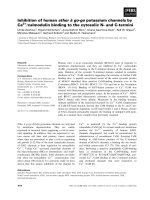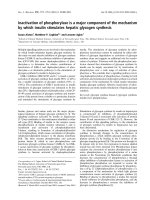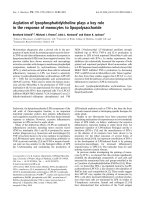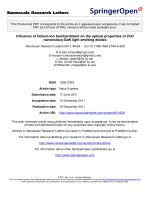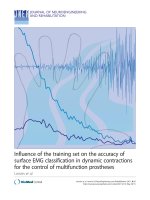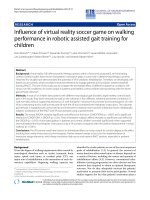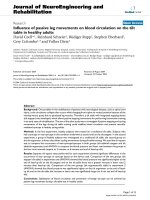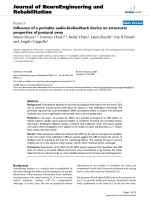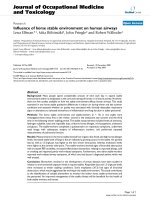Báo cáo khao học: "Influence of the dual arbuscular endomycorrhizal / ectomycorrhizal symbiosis on the growth of Acacia holosericea (A. Cunn. ex G. Don) in glasshouse conditions" pptx
Bạn đang xem bản rút gọn của tài liệu. Xem và tải ngay bản đầy đủ của tài liệu tại đây (70.66 KB, 6 trang )
H. Founoune et al.Dual arbuscular endomycorrhizal / ectomycorrhizal symbiosis on Acacia holosericea
Original article
Influence of the dual arbuscular
endomycorrhizal / ectomycorrhizal symbiosis
on the growth of Acacia holosericea
(A. Cunn. ex G. Don) in glasshouse conditions
Hassna Founoune
a,b
, Robin Duponnois
c,*
, Amadou Moustapha Bâ
d
and Fouad El Bouami
b
a
IRD, Laboratoire de Bio-pédologie, B.P. 1386, Dakar, Senegal
b
Université Moulay Ismaïl, Laboratoire de Biotechnologie et d’Amélioration des Plantes, B.P. 4010, Meknes, Morocco
c
UR IBIS “Interactions Biologiques dans les Sols des Systèmes Anthropisés Tropicaux”, 01 BP182, Ouagadougou, Burkina Faso
d
ISRA, Direction des Recherches sur les Productions Forestières, BP 2312, Dakar, Senegal
(Received 9 October 2000; accepted 15 May 2001)
Abstract – Acacia holosericea plants were inoculated with a strain of Glomus aggregatum IR27 (arbuscular mycorrhizal fungus), Piso-
lithus tinctorius COI024 (ectomycorrhizal fungus) or with both fungi. Each fungus inoculated alone stimulated plant growth (height and
shoot biomass). The response to the dual inoculation was greater than the response to either inoculant one. It may be due to the fact that
the co-inoculated plants formed nodules through contaminations. However these nodules are inefficient as the N concentrations were si-
milar in leaves of all inoculated plants with mycorrhizal fungi, alone and together. In thus, P, Ca, K, Mg and Na concentrations were not
improved with respect to dual inoculation. The ectomycorrhizal colonization was significantly higher in the dually inoculated treatment
than in either of the singly inoculated treatments.
acacia / arbuscular mycorrhizas / ectomycorrhizas / dual inoculation
Résumé – Influence de la double symbiose endomycorhiziennne et ectomycorhiziennne sur la croissance de Acacia holosericea
(A. Cunn. exG.Don.) en conditionsde serre. Des plants de Acacia holosericea ont été inoculés soit avec une souche deGlomus aggre-
gatum IR27 (champignon mycorhizien à arbuscules), soit avec Pisolithus tinctorius COI024 (champignon ectomycorhizien) ou avec les
deux symbiotes fongiques. Chaque champignon a stimulé la croissance de la plante hôte (hauteur et biomasse aérienne). La double
inoculation a induit une augmentation du développement de la plante supérieure à celle enregistrée lorsque les champignons étaient
inoculés séparément.Ceci peut être la conséquence de laformation de nodulesdus à des souches de Rhizobia contaminatrices. Toutefois,
ces bactéries restent peu efficientes puisque les concentrations en azote dans les feuilles sont similaires dans les traitements avec chaque
champignon ou lorsque ces isolats fongiques sont co-inoculés. Les concentrations en P, Ca, K, Mg et Na n’ont pas été modifiées par la
co-inoculation. La colonisation racinairepar P. tinctorius COI024 a été significativement améliorée lorsque ce dernier a été inoculé avec
le champignon mycorhizien à arbuscules.
acacia / mycorhizes à arbuscules / ectomycorhizes / double inoculation
Ann. For. Sci. 59 (2002) 93–98
93
© INRA, EDP Sciences, 2002
DOI: 10.1051/forest: 2001008
* Correspondence and reprints
Tel: +226 30 67 37/39; Fax: +226 31 03 85; e–mail:
1. INTRODUCTION
Acacia is the largest mimosoid genus which is repre-
sented with 800–900 species. They are abundant in sa-
vannas and arid regions of Australia, Africa, India and
the Americas. They can grow in nitrogen–deficient soils
because of their symbiosis with nitrogen fixing bacteria.
As with many N
2
-fixing trees and shrubs, Acacia is very
dependent on mycorrhizas to absorb nutrients required
for plant growth and efficient N
2
fixation [6]. Depending
on the fungal groups and the Acacia species, two
morphological types of mycorrhizas can be distin-
guished, namely arbuscular mycorrhizas (AM) and
ectomycorrhizas (EM) [19]. Generally, the former AM
seem to be predominant in Acacia [1, 7]. The African
Acacia form mycorrhizal associations only with AM
fungi [5] but, as with other introduced tree genera in
West Africa like Casuarina and Eucalyptus, some Aus-
tralian Acacia are known to be associated with either
ectomycorrhizal and/or endomycorrhizal fungi [19, 8].
For instance, A. holosericea can form symbiotic relation-
ships with AM fungi [6, 1] and also with EM fungi [2,
10]. This dual fungal association has been described
within the same root system of A. holosericea under natu-
ral conditions in Senegal by Ducousso (1990) [8].
However, the symbiotic effectiveness of dual endo-
mycorrhizal / ectomycorrhizal inoculation has never
been assessed under experimental conditions for Austra-
lian Acacia. The purpose of this study was to evaluate the
functional compatibility of a dual inoculation with A.
holosericea and two mycorrhizal fungi, using the
ectomycorrhizal fungus Pisolithus tinctorius and the
arbuscular mycorrhizal fungus Glomus aggregatum
growing in a soil collected in Senegal.
2. MATERIALS AND METHODS
2.1. Preparation of fungal inoculum
A strain of Pisolithus albus COI 024(Martin,personal
communication) was isolated from a sporocarp collected
in a monospecific forest plantation of A. holosericea in
southern Senegal during the rainy season. This fungal
isolate, probably introduced from Australia (Martin, per-
sonal communication), was previouslytested for its com-
patibility with A. holosericea in a pot experiment [10].
The fungal strain was maintained in Petri dishes over
MMN agar medium at 25
o
C [22]. The fungal inoculum
was prepared according to Duponnois and Garbaye [9].
Briefly, one liter glass jars were filled with 600 mL of a
mixture of vermiculite and peat moss (4:1, v:v) and
autoclaved (120
o
C, 20 min). The substrate was then
moistened to field capacity with 300 ml liquid MMN me-
dium, the jars sealed and autoclaved at 120
o
C for
20 min. After cooling, the substrate was inoculated with
10 fungal plugs taken from themarginof fungal colonies.
The glass jars were placed at 25
o
C in the dark for
2 months.
The arbuscular mycorrhizal fungus G. aggregatum
(isolate IR 27) was isolated in Burkina Faso by Bâ et al.
(1996) [1]. It was propagated on millet (Penisetum
typhoïdes cv. IKMV 8201) for 12 weeks in a glasshouse
on an autoclaved sandy soil (140
o
C, 40 min). Before in-
oculation, the millet plantswere uprooted, gently washed
with tap water and cut into segments 0.5 cm long. The
roots were not surface-disinfected. Non-mycorrhizal
millet roots, prepared as above, were used for the treat-
ments without endomycorrhizal inoculation.
2.2. Inoculation and plant culture
The experiment was performedwith soil collected in a
fallow area at Nioro du Rip (center of Senegal). After
sampling, the soil was crushed, passed through a 2-mm
sieve and autoclaved for 40 min at 140
o
C to eliminate
the indigenous microflora. The physical and chemical
characteristics of the autoclaved soil were as follow: clay
8.7%; fine loam 6.5%; coarse loam 17.6%; fine sand
40.8%; coarse sand 25.6%; Total C 4.4%; Total nitrogen
0.39%; C/N 11.3; Total P 54.7 mg kg
–1
;pH(H
2
O) 5.8.
Seeds of A. holosericea (provenance Bel Air, Dakar)
were surface sterilized in 95% sulphuric acid for 60 min,
rinsed with sterilized distilled water and germinated on
1% agar at 25
o
C in the dark. The 0.5 dm
3
pots were filled
with the autoclaved soil. One hole (1 cm by 5 cm) was
made in each pot, filled with 1 g fresh Millet root
(mycorrhizal or not) and/or 2 cm
3
of the ectomycorrhizal
inoculum (or the vermiculite – peat mixture (4:1; v:v)
moistened with liquid MMN medium but without fungus
for the treatments without P. tinctorius COI 024). The
holes were then covered with the same autoclaved soil.
The 4 treatments were realized as: (1) non-inoculated
plants, (2) G. aggregatum IR 27 alone, (3) P. tinctorius
COI 024 alone and (4) dual inoculation G. aggregatum +
P. tinctorius. Each inoculation treatment was sown with
one pre-germinated seed per pot. The plants were ar-
ranged in a randomized, complete block design with
10 replicates per treatment. They were placed in a
94 H. Founoune et al.
glasshouse during the hot season under natural light
(daylight approximatively 12 h, mean temperature 30
o
C
day) and watered twiceweekly without fertiliser during 6
months of growth.
2.3. Quantitative evaluation
The height of each plant was measured. The A.
holosericea plants were uprooted and the root systems
gently washed with tap water. Then the root systems
were cut into short pieces, mixed and the ecto-
mycorrhizal colonization (number of ectomycorrhizal
short roots / total number of short roots × 100)was deter-
mined under a stereomicroscope at 160 × magnification
on a random sample of at least 100 short roots. Other root
samples were randomly collected along the root system
to quantify the internal colonization of arbuscular
mycorrhizal fungi in the roots. The roots were cleared
and stained according to the method of Phillips and
Hayman (1970) [23]. Theextent of colonization was esti-
mated in terms of fraction of root length with visible
mycorrhizal structures (length of root fragments colo-
nized / total length of root fragments × 100). The roots
were cut into approximately 1-cm pieces and placed on a
slide for microscopic observation at 250 × magnifica-
tion [3]. About one hundred 1-cm-root pieces were ob-
served per plant.
Although the soil was autoclaved and the seeds sur-
face disinfected, some plants were contaminated with in-
digenous rhizobia. The main explanation of this
contamination was that the irrigation water possibly con-
tained N
2
-fixing bacteria. Root nodules were counted and
their dry weights (60
o
C, 1 week) were determined.
The dry weight of shoots and roots was measured
(60
o
C, 1 week). After drying, a subsample of ground
shoot tissues were ashed (500
o
C), digested in 2 mL HCl
6 M and 10 mL HNO
3
1 M, then analysed by colorimetry
for P [17], by flame emission for Na, K and by atomic ab-
sorption spectroscopy for Mg. Plant tissues were di-
gested in 15 mL H
2
SO
4
18 N containing 50 g L
–1
salicylic acid for N (Kjeldhal) determination.
Mycorrhizal dependency was determined as fol-
low [24]:
((shoot biomass of ectomycorrhizal plants – shoot bio-
mass of the non ectomycorrhizal plants) × 100) / (shoot
biomass of ectomycorrhizal plants).
2.4. Statistical analysis
All data were subjected to a one-way analysis of vari-
ance using the Super Anova Computer program and
means were compared with the Newman-Keuls multiple
range test (P = 0.05). For the mycorrhizal rate, the data
were transformed by arcsin(
x
) before statistical analy-
sis.
3. RESULTS
The height and shoot dry weight of the plants inocu-
lated with G. aggregatum IR 27 or P. tinctorius COI 024
were significantly higher than in the control (table I).
Compared with the control, growth of G. aggregatum IR
27 plants, was stimulated by 1.71 × and 3.02 × for
height and shoot dry weight, respectively, whereas it was
Dual arbuscular endomycorrhizal / ectomycorrhizal symbiosis on Acacia holosericea 95
Table I. Influence of the fungal treatments on the growth of A. holosericea and on the nitrogen fixative symbiosis after 6 months of
culture.
Treatments Height
(cm)
Shoot dry weight
(mg/plant)
Root dry weight
(mg/plant)
Number of nodules
per plant
Nodule dry weight
(mg/plant)
Not inoculated 10.9 a
(1)
800 a 333 a 0 a 0 a
G. aggregatum 29.6 b 3217 b 750 a 0 a 0 a
P. tinctorius COI 024 29.2 b 3217 b 1050 a 0 a 0 a
G. aggregatum + P. tinctorius COI 024 46.7 c 4557 c 3143 b 4.3 b 34.4 b
(1)
For each parameter,data in thesame column followedby the same letter are not significantlydifferent according tothe Newman andKeuls test (P< 0.05).
1.68 × and 3.02 × , respectively, for plants inoculated
with P. tinctorius COI 024. There were no significant dif-
ference between the fungal treatments. Root biomass of
mycorrhizal treatments were not significantly different
from the control (table I). When the two fungi were co-
inoculated, height and shoot dry weight were signifi-
cantly increased over the single inoculation treatments
(table I). The percentages of growth stimulation calcu-
lated from the means of the fungal treatments
(G. aggregatum IR 27 alone or P. tinctorius COI024
alone) were 0.57 × for the plant height, 0.42 × and
2.5 × for the shoot and root dry weight, respectively
(table I).
No nodules were observed in the control or in the
G. aggregatum IR 27 or P. tinctorius COI 024 treat-
ments. On the contrary, the formation of nodules was re-
corded with 85% of plants inoculated with both fungi
(table I).
The dual fungal inoculation significantly increased
the establishment of the ectomycorrhizal symbiosis as
compared with the plants infected by the ecto-
mycorrhizal strain only (table II). No significant
differences were recorded for the endomycorrhizal sym-
biosis (table II).
The nitrogen concentrations in leaves of A.
holosericea was significantly lower in the fungal treat-
ments than in the control (table III). On the contrary, the
total nitrogen content in the aerial parts of the plants in
the endomycorrhizal and/or ectomycorrhizal treatments
were significantly higherthan in the control (20.2 mg per
control plant; 55.9 mg per endomycorrhizal plant;
63.0 mg per ectomycorrhizal plants and 78.4 mg per co-
inoculated plant). This is presumably a consequence of
increased plant growth diluting plant N concentrations.
On the contrary, the K concentrations were significantly
higher in the leaves of the mycorrhizal plants (table III).
Compared with the control, no significant differences
were recorded for the P and Mg contents of the inocu-
lated plants (table III). The Ca and Na concentrations
were significantly lower in the P. tinctorius COI 024
treatment than in the control and G. aggregatum IR 27
treatments (table III). The type of fungal symbiosis influ-
enced the mineral contents of the leaves differently. The
concentrations of P, Ca, Mg and Na were significantly
96 H. Founoune et al.
Table II. Mycorrhizal establishment on the root systems of A. holosericea after 6 months of growth.
Treatment Ectomycorrhizal colonization
(%)
Mycorrhizal dependency
(%)
Endomycorrhizal colonization
(%)
Not inoculated 0 a
(1)
0a 0a
G. aggregatum 0 a 73.4 b 41.7 b
P. tinctorius COI 024 54.2 b 70.8 b 0 a
G. aggregatum + P. tinctorius COI 024 83.2 c 94.4 c 49.4 b
(1)
For each parameter,data in thesame column followedby the same letter are not significantlydifferent according tothe Newman andKeuls test (P< 0.05).
Table III. Effect of the fungal inoculation on the N, P, Ca, Mg, Na and K concentrations in leaves of A. holosericea after 6 months of
growth.
Treatment P (%) Ca (%) Mg (%) Na (%) K (%) N (%)
Not inoculated 0.043 ab
(1)
1.53 b 0.287 ab 0.123 b 0.49 a 2.52 b
G. aggregatum 0.070 b 1.55 b 0.330 b 0.097 b 0.90 c 1.74 a
P. tinctorius COI 024 0.030 a 1.27 a 0.273 a 0.053 a 0.83 bc 1.96 a
G. aggregatum + P. tinctorius COI 024 0.037 ab 1.38 ab 0.323 b 0.103 b 0.76 b 1.72 a
(1)
For each parameter,data in thesame column followedby the same letter are not significantlydifferent according tothe Newman andKeuls test (P< 0.05).
higher in the G. aggregatum IR 27 treatment than in the
P. tinctorius COI024 treatment (tableIII). The percent-
age of ectomycorrhizal dependency responses were not
different between the endo- and ectomycorrhizal plants
but significantly enhanced when both fungi were inocu-
lated (tableII).
4. DISCUSSION
Acacia holosericea is usually considered to be
endomycorrhizal dependent [25, 27]. In fact, this symbi-
otic association was previously studied by Cornet and
Diem [6] in Senegal and by Bâ et al. (1996) [1] in
Burkina Faso. Cornet and Diem [6] found that the growth
of A. holosericea plants was greatly stimulated by the
arbuscular mycorrhizal fungus Glomus mosseae in a pot
experiment and under field conditions. The efficiency of
this symbiosis (expressed as growth promotion resulting
from the fungal symbiosis) was also described with
G. fasciculatum [26]. Ectomycorrhizal vs. endo-
mycorrhizal fungi within the same root system of A.
holosericea have been observed in Senegal [8]. The
ectomycorrhizal fungus Pisolithus sp. was involved in
this symbiosis as a fungal symbiont partner. Recently, a
positive effect of this fungal isolate was demonstrated on
A. holosericea plants growing in a pot experiment [10].
The measurements of the mycorrhizal rates suggests
that both these fungal symbionts can coexist without any
competition on the root system of A. holosericea seed-
lings. Moreover, ectomycorrhizal colonization was stim-
ulated by dual inoculation. Similar observations were
made on Eucalyptus spp. [18]. The dual ectomycorrhizal
/ endomycorrhizal symbiosis has also been studied with
Eucalyptus urophylla and E. globulus with a sandy soil
[4]. These authors have shown a significant interaction
between ectomycorrhizal and endomycorrhizal inocula-
tion and their effectson plant growth response. However,
some results contradict the coexistence of both symbi-
onts in the same root system. For instance, Lodge [21]
observed that infection by AM fungi in the field was low-
est where infection by ectomycorrhizal fungi was high,
suggesting an antagonism among the fungal symbionts
of Populus and Salix.
Furthermore, we found a better promoting effect on
growth of A. holosericea seedlings of the dual inocula-
tion with two different mycorrhizal fungi as compared
with single inoculation. However wecannotattribute this
stimulation only to the mycorrhizal symbiosis because of
the presence of nodules on the ecto/endomycorrhizal
seedlings. The ability of A. holosericea roots to form
nodules with bacteria fixing atmospheric nitrogen has
been already described [6]. The efficiencyofthe nitrogen
fixation is dependent on mycorrhizalinoculation[6]. The
main explanation is that the improvement of P uptake by
the host plant resulting from endomycorrhizal symbiosis
enhances nodulation and N
2
fixation [6]. Comparable ob-
servations have been reported for the dual effect of
arbuscular mycorrhiza and Rhizobium with Acacia spe-
cies such as A. mangium, A. auriculiformis and A.
falcataria [7]. In our study, we collected a low number of
nodules on rootsof co-inoculated plants through contam-
ination. We cannot explain the absence of nodules on
these treatments. Usually, the rhizobial contaminations
coming from the irrigation are observed in the control
treatments not inoculated with selected microorganisms
[12–14]. However, the plant growth response to the dual
inoculation might not be a response to nodule formation.
Although the ectomycorrhizae and endomycorrhizae can
be detected after one month after fungal inoculations, we
have not recorded any nodules during the first two
months of culture which suggest that the effect of this
bacterial symbiosis could have a lesser impact than the
mycorrhizae on the plant nutrition. The nitrogen concen-
tration in the shoot dry weight was lower in the ecto
and/or endomycorrhizal plants but the total nitrogen con-
tent in the aerial parts was significantly higher in the
mycorrhized plants. This positive effect of the
mycorrhizal fungi has already been observed with the
Pisolithus sp. / A. mangium symbiosis on the same soil
[11]. The Ca, Mg, Na and K concentrations in leaves of
A. holosericea were variable depending on mycorrhizal
fungi involved alone or together. For example, the Kcon-
centrations in the leaves of inoculated plants with G.
aggregatum alone were higher than that of co-inoculated
plants. K plays a major role in plant water relations [16].
The lower susceptibility of potassium–sufficient plants
to drought stress is related to several factors such as (i)
the role of K in stomatal regulation as a mechanism con-
trolling the water regime in higher plants and (ii) the im-
portance of K for the osmotic potential in the vacuoles
[16]. These physiological effects due to mycorrhizal
symbiosis could be of a great interest to the development
of A. holosericea in the drought sahelian areas. Surpris-
ingly, P concentrations in leaves of A. holosericea seed-
lings were not improved by mycorrhizal inoculation.
Nevertheless, the absorption of P is the major contribu-
tion of the mycorrhizal fungi for plant growth [15]. We
hypothezize that non-nutritional effects of mycorrhizal
fungi (e.g. protection against pathogens, water uptake)
could play a major role rather than nutritional effects.
Dual arbuscular endomycorrhizal / ectomycorrhizal symbiosis on Acacia holosericea 97
Further research must be undertaken to measure the
ecological importance of this dual mycorrhizal symbio-
sis. Thus, studies must be done with Australian Acacia to
determine how to manage the four-partner association
plant/Rhizobium/arbuscular mycorrhizal fungus/ecto-
mycorrhizal fungus for a selection of the convenient mi-
crobial combinations for plant growth.
REFERENCES
[1] Bâ A.M., Dalpé Y., Guissou T., Les Glomales d’Acacia
holosericea et d’Acacia mangium, Bois Forêts Tropiq. 250
(1996) 5–18.
[2] Bâ A.M., Garbaye J., Dexheimer J., The influence of cul-
ture conditions on mycorrhiza formation between the ectomy-
corrhizal fungus Pisolithus sp. and Afzelia africana Sm.
Seedlings, Mycorrhiza 4 (1994) 121–129.
[3] Brundrett M.C., Piche Y., Peterson R.L., A developmen-
tal study of the early stages in vesicular-arbuscular mycorrhizal
formation, Can. J. Bot. 63 (1985) 184–194.
[4] Chen Y.L., Brundrett M.C., Del B., Effects of ectomy-
corrhizas and vesicular–arbuscular mycorrhizas, alone or in
competition, on root colonization and growth of Eucalyptus glo-
bulus and E. urophylla, New Phytol. 146 (2000) 545–556.
[5] ColonnaJ.P., Thoen D., Ducousso M., Badji S.,Compara-
tive effects of Glomus mosseae and P fertilized on foliar mineral
composition of Acacia senegal seedlings inoculated with Rhizo-
bium, Mycorrhiza 1 (1991) 35–38.
[6] Cornet F., Diem H.G., Étude comparative de l’efficacité
des souches de Rhizobium d’Acacia isolées de sols du Sénégal et
effet de la double symbiose Rhizobium – Glomus mosseae sur la
croissance de Acacia holosericea et A. raddiana, Bois Forêts
Tropiq. 198 (1982) 3–15.
[7] de la Cruz R.E., Manalo M.Q., Aggangan N.S., Tambalo
J.D., Growth of three legume trees inoculated with VA mycorr-
hizal fungi and Rhizobium, Plant Soil 108 (1988) 111–115.
[8] Ducousso M., Importance des symbioses racinaires pour
l’utilisation des acacias d’Afrique de l’Ouest. Thèse de doctorat
de l’Université Montpellier, 1990, 197 p.
[9] Duponnois R., Garbaye J., Techniques for controlled syn-
thesis of the Douglas fir-Laccaria laccata ectomycorrhizal sym-
biosis, Ann. Sci. For. 48 (1991) 239–251.
[10] Duponnois R., Founoune H., Bâ A.M., Plenchette C., El
Jaafari S., Neyra M., Ducousso M., Ectomycorrhization of Aca-
cia holosericea A. Cunn. ex G. Don by Pisolithus spp. in Sene-
gal: Effect on plant growth and on the root-knot nematode
Meloidogyne javanica, Ann. For. Sci. 57 (2000) 305–392.
[11] Duponnois R., Bâ A.M., Growth stimulation of Acacia
mangium Willd by Pisolithus sp. in some Senegalese soils, For.
Ecol. Manag. 119 (1999) 209–215.
[12] Duponnois, R., Cadet, P., Senghor K., Sougoufara B.,
Etude de la sensibilité de plusieurs acacias australiens au nématode
à galles Meloidogyne javanica, Ann. Sci. For. 54 (1997) 181–190.
[13] Duponnois R., Senghor K., Mateille T., Pathogenicity of
Meloidogyne javanica (Treub) Chitw. to Acacia holosericea (A.
Cunn. ex G. Don) and A. seyal (Del.), Nematologica 41 (1995)
480–486.
[14] Duponnois R., Tabula T.K., Cadet P., Étude des interac-
tions entre trois espèces d’Acacia (Faidherbia albida Del., A.
seyal Del., A. holosericea A. Cunn. ex G. Don) et Meloidogyne
mayagensis au Sénégal, Can. J. Soil Sci. 77 (1997) 359–365.
[15] Harley J.L., Smith J.E., Mycorrhizal Symbiosis, Acade-
mic Press Inc., New York, London, 1983, 483 p.
[16] Hsiao T.C., Läuchli G.W., Role of potassium in
plant–water–relations, in: Tinker B., Läuchli, A., (Eds.), Advan-
ces in Plant Nutrition. Vol. 2, Praeger Scientific, New York,
1986, pp. 281–312
[17] John M.K., Colorimetric determination in soil and plant
material with ascorbic acid, Soil Sci. 68 (1970) 171–177.
[18] Lapeyrie F., Chilvers G.A., An endomycorrhiza–ecto-
mycorrhiza succession associated with enhanced growth of Eu-
calyptus dumosa seedlings planted in a calcareous soil, New
Phytol. 100 (1985) 93–104.
[19] Le Tacon F., Garbaye J., Bâ A.M., Beddiard A., Diagne
O., Diem H.G., L’importance des symbioses racinaires pour les
arbres forestiers en zone tropicale sèche et en zone tropicale hu-
mide, in: Trees and Development, IFS-ICRAF-IUFRO, Proc.
IFS Seminar, 20–25 February 1989, Nairobie, 1989, pp. 33–45.
[20] Lindhauer M.G., Influence of K nutrition and drought of
water relations and growth of sunflower (Helianthus annuus L.),
Z. Pflanzenernähr. Bodenk. 148 (1985) 654–669.
[21] Lodge D.J., The influence of soil moisture and flooding
on formation of VA-endo– and ectomycorrhizae in Populus and
Salix, Plant Soil 117 (1989) 243–253.
[22] Marx D.H., The influence of ectotropic mycorrhizal fun-
gi on the resistance of pine roots to pathogenic infections. I.
Antagonism of mycorrhiral fungi to root pathogenic fungi and
soil bacteria, Phytopathol. 59 (1969) 153–163.
[23] Phillips J.M., Hayman D.S., Improved procedures for
clearing roots and staining parasitic and vesicular-arbuscular
mycorrhizal fungi for rapid assessment of infection, Trans. Brit.
Mycol. Soc. 55 (1970) 158–161.
[24] Plenchette C., Fortin J.A., Furlan V., Growth responses
to several plant species to mycorrhizae in a soil of moderate
P-fertility. I. Mycorrhizal dependency under field conditions,
Plant Soil 70 (1983) 199–209.
[25] Reddell P., Warren R., Inoculation of acacias with my-
corrhizal fungi: potential benefits, in: Turnbull J.W. (Ed.), Aus-
tralian Acacias in Developping Countries. ACIAR Proc. No. 16,
Camberra, 1987, pp. 50–53.
[26] Senghor K., Étude de l’incidence du nématode phytopa-
rasite Meloidogyne javanica sur la croissance et la symbiose
fixatrice d’azote de douze espèces d’Acacia (africains et austra-
liens) et mise en évidence du rôle des symbiotes endo et ectomy-
corhiziens contre ce nématode. Thèse de Doctorat de 3
e
cycle de
l’Université Chekh Anta Diop, Dakar, 1998, 123 p.
[27] Warcup J.H., Ectomycorrhizal associations of australian
indigenous plants, New Phytol. 85 (1980) 531–535.
98 H. Founoune et al.
